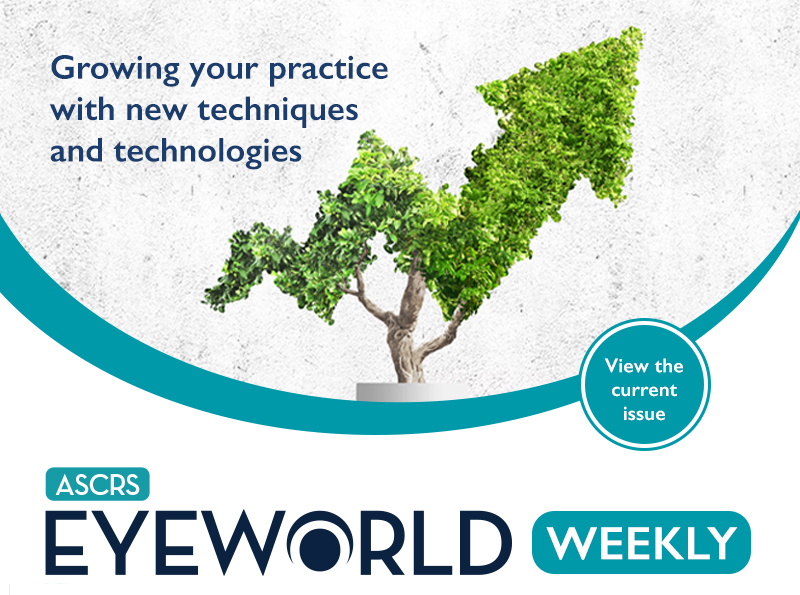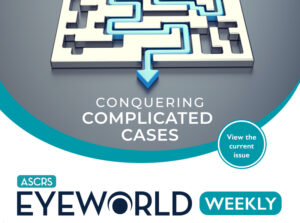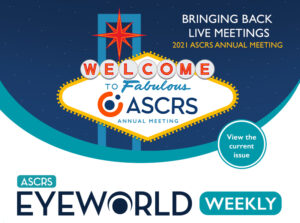Long-term safety, efficacy data reported from standalone MIGS procedure
Sight Sciences announced 36-month safety and efficacy results from patients with open angle glaucoma who received the OMNI Surgical System procedure (canaloplasty followed by trabeculotomy) on a standalone basis (without concomitant cataract surgery). The study showed a mean 20% reduction in IOP in all eyes (38 eyes, 26 patients) at 36 months of follow-up. Mean IOP decreased from 24.6±3.2 mm Hg (after medication washout) to 14.5±1.7 mm Hg, 14.2±2.0 mm Hg, and 15.0±1.9 mm Hg at 12, 24, and 36 months postop, respectively. Use of IOP-lowering medications was reduced from 1.9±0.7 to 0.4±0.6, 0.6±0.7, and 0.5±0.7 at 12, 24, and 36 months, respectively. The company’s press release noted that the IOP and medication reduction remained consistent over the 3 years postop, suggesting durability of the procedure.
Positive clinical data in ongoing trial for investigational thyroid eye disease treatment
Viridian Therapeutics announced positive data from its ongoing Phase 1/2 clinical trial of VRDN-001 for treatment of active thyroid eye disease. VRDN-001 is an anti-IGF-1R antibody administered intravenously. The trial is evaluating two infusions of the treatment. Effect on proptosis, clinical activity score, and diplopia are being reviewed. According to the company’s press release, 6 weeks after the two 10 mg/kg VRDN-001 infusions, 83% of participants had a proptosis response (mean reduction of 2.4 mm from baseline), 83% of participants achieved a 0 or 1 clinical activity score (reduced from a mean of 4.3), and 75% experienced complete resolution of diplopia. No serious adverse treatment-related events occurred.
Bioengineered cornea restores vision in 20 people
Researchers from Linkoping University and LinkoCare Life Sciences AB published research describing a bioengineered cornea that has restored vision in several patients who had advanced keratoconus. The study, published in the journal Nature Biotechnology, described a cell-free engineered corneal tissue made from collagen molecules derived from pig skin that was double crosslinked and implanted with a minimally invasive surgical method that didn’t involve removing existing corneal tissue or using sutures. The pilot feasibility study, which took place in India and Iran, saw no adverse events in the 24 months of follow-up. The investigators recorded improvements in corneal thickness, maximum keratometry, and visual acuity. According to the paper, 14 of the patients who were blind preop had a final mean BCVA with spectacles or contact lenses of 20/36 after the procedure. A news article from the university described the bioengineered implant as an alternative to donor corneas, stating that these bioengineered corneas can be stored for up to 2 years. According to the news article, a larger clinical study is needed, followed by regulatory approval, before widespread application of this technique. The researchers also plan to study whether this method could be used for other ocular conditions.
ASCRS news and events
- ASCRS Annual Meeting: The call for abstract submissions for the 2023 ASCRS Annual Meeting is open now through October 14.
- ASCRS app: Have you downloaded and logged in (use your ASCRS ID or create one) to the new ASCRS app? Learn more about the app and how to download here.
Research highlights
- Visual outcomes following bilateral implantation of presbyopia-correcting IOLs were assessed in research published in the journal Eye. Patients bilaterally received the PanOptix IOL (Alcon), AT LISA tri IOL (Carl Zeiss Meditec), or the Symfony IOL (Johnson & Johnson Vision). At 6 months postop, uncorrected intermediate visual acuity at 80 cm was better in the AT LISA and Symfony groups than PanOptix, while it was better at 60 cm in the Symfony and PanOptix groups compared to AT LISA. The authors noted a worse DCNVA in the Symfony group. At a defocus of –2.5 D, the near visual acuity in the PanOptix and AT LISA was similar and significantly better than Symfony, according to the researchers. Binocular photopic and scotopic contrast sensitivity was similar among the three group at all distances. The authors noted that more patients reported a need for reading glasses in the Symfony group. They concluded that “PanOptix IOL and AT LISA IOL would be a good choice for patients aiming for an optimum near vision, while Symfony IOL seems suitable for patients having the priority for good intermediate vision.”
- A novel comanagement strategy for postop management and light delivery treatments for the Light Adjustable Lens (LAL, RxSight) is described in a paper published in Clinical Ophthalmology. According to the paper, which evaluated a retrospective observational case series of 33 patients (62 eyes) receiving this IOL and subsequent comanagement strategy, a single, open-access facility employed two specialists to use the Light Delivery Device (LDD) for the postop refractive treatments for the LAL patients from 16 referring surgeons. The paper noted that the physicians “provide continuous communication with referring surgeons throughout the patient’s LDD treatment process.” Of the 62 eyes included in the study, 33 receiving the LAL 2.0 had previous corneal refractive surgery. Thirty-six total eyes and 20 post-refractive eyes had an emmetropic refractive target. Of the total eyes with this goal, 97.2% saw 20/20 or better, and all were within 0.5 D of plano. Of the eyes that were post-refractive with an emmetropic goal, 95% saw 20/20 or better postop. The authors concluded that this “co-managed, open-access methodology using the LAL 2.0 was safe and efficacious even in challenging postrefractive clinical scenarios.”
Product news
- TYRVAYA Nasal Spray (varenicline, Oyster Point Pharma) will be added to Medicare Part D formularies effective September 1.
This issue of EyeWorld Weekly was edited by Stacy Jablonski and Liz Hillman.
EyeWorld Weekly (ISSN 1089-0319), a digital publication of the American Society of Cataract and Refractive Surgery (ASCRS), is published every Friday, distributed by email, and posted live on Friday.
Medical Editors: Sumit “Sam” Garg, MD, Chief Medical Editor; Rosa Braga-Mele, MD, Cataract Editor; Clara Chan, MD, Cornea Editor; Nathan Radcliffe, MD, Glaucoma Editor; and Vance Thompson, MD, Refractive Editor
For sponsorship opportunities or membership information, contact: ASCRS • 12587 Fair Lakes Circle • Suite 348 • Fairfax, VA 22033 • Phone: 703-591-2220 • Fax: 703-591-0614 • Email: ascrs@ascrs.org
Mention of products or services in EyeWorld Weekly does not constitute an endorsement by ASCRS.
Click here to view our Legal Notice.
Copyright 2022, EyeWorld News Service, a division of ASCRSMedia. All rights reserved.




